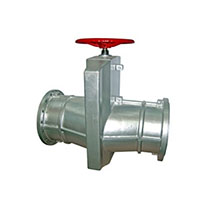What is a Pinch Valve?
Pinch Valve Basics
Pinch valve is squeezed by pneumatic, electric, manual or hydraulic driving methods to achieve the role of switching/ adjusting. A pinch valve is a valve that uses flexible tubing that can be pinched or compressed to shut off the flow of fluid or gas through the valve. When the sleeve is not clamped, the valve opens and fluid or gas can flow through it. ATO online store will explain how pinch valves work and their types and advantages.
Working Principle
Pinch valves have a simple design and few moving parts, and are typically used in applications where the fluid being handled is corrosive or abrasive, or where precise flow control is not required. Depending on the application, pinch valves can be operated manually, pneumatically, or electrically. The working principle of a pinch raft is based on fluid dynamics and mechanical mechanics. Although the drive is different, the switch is ultimately controlled by squeezing or loosening the hose. As the fluid passes through the pipe, the raft is subjected to the pressure of the fluid and the force of the drive. Under the influence of both, the raft is closely attached to the inner wall of the pipe, and the fluid is sealed. When the drive changes the opening of the raft, the flow rate of fluid changes in the pipe at the same time.
Pinch Valve Types
The pinch valves can be broadly described as two categories: One is pinch valves with integrated sleeves, the another is bodies and pinch bodies with separate clamps to clamp the tube or hose.
- The casing (hose) is the most important part of the pinch valve, providing resistance to corrosion, wear and pressure.
- The quality of internal parts such as solenoid coils, armatures, springs and so on also affects the life of the valve.
- Pinch valves can be operated manually (such as manual pinch valve), pneumatically or electrically, depending on the application.

Advantages
- Compact structure: The structure of the clamp raft is relatively simple, small in size, light in weight, and easy to install and maintain.
- Good sealing performance: The clamping raft adopts a conical valve core and sealing ring, which has good sealing performance and prevents fluid leakage.
- Easy to operate: The clamping raft is operated by a handwheel or joystick, which does not require special skills and is convenient for on-site operation.
- Good wear resistance: The valve core and sealing ring are made of wear-resistant materials, which have a long service life.
- Wide range of application: The pinch raft can be applied to all kinds of fluids, including water, oil, steam, etc. , with a wide range of temperature and pressure.
- Energy saving and consumption reduction, reasonable price: When adjusting the flow rate, the clamp raft can effectively reduce the resistance loss of the fluid and reduce the energy consumption.
- The electromagnetic pinch valve (referred to as the pinch valve) is driven by an electromagnetic solenoid, which controls the on-off by squeezing or loosening the hose. The medium only passes through the hose and the other parts of the valve body do not come into contact with the medium, which means that in contrast to other types of solenoid valves, the pinch valve can pass through the particle-laden medium without clogging.
Application Scenarios
- Pinch valves are used for on/off applications as well as throttling services. They are used in cleaning or sanitation services, such as the chemical, food and pharmaceutical industries, as well as in more industrial services, such as wastewater, the cement industry and systems with high concentrations of bulk solids.
- Pinch valves are used in sanitary facilities to improve cleanability , and are also used in more industrial equipment due to their low friction and resistance to clogging. Compared to other more common valve types, such as butterfly valves, ball valves, and similar valves, it perform well in these services. Because their simplicity and the virtue of their ancient nomenclature, it is cost-effective.
Summary
As a kind of fluid control equipment, the pinch valve has the advantages of simple structure, good sealing performance, rapid opening and closing, etc. , and is widely used in various industrial pipeline systems and municipal projects. Understanding its usage, working principles, advantages and application scenarios will help us better play its role in actual work and improve fluid control effects.

